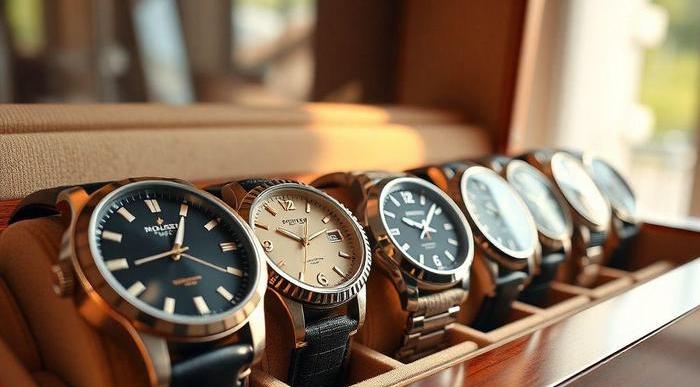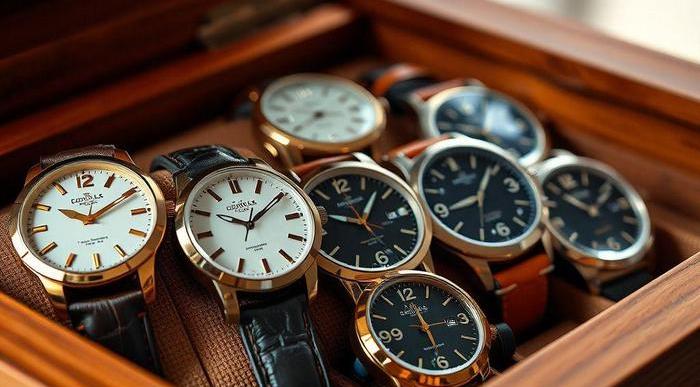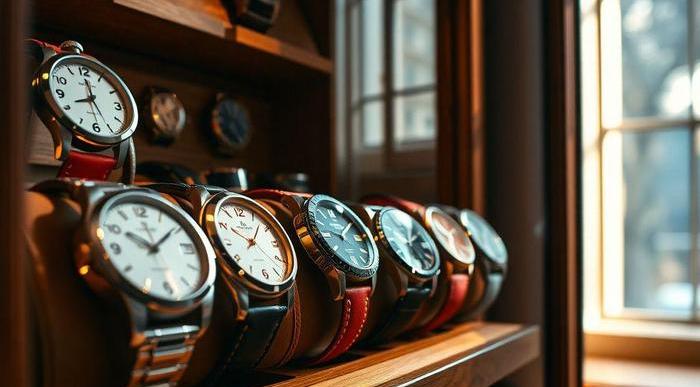Understanding Watch Movements: Mechanical, Automatic And Quartz
Note: This page contains affiliate links.
As an Amazon Associate, I earn from qualifying purchases when you click on the link, but you are not charged extra.
In the world of horology, watch movements serve as the heart and soul of every timepiece, driving the hands and complications with intricate engineering. Watch movements can be categorized into three primary types: mechanical, automatic, and quartz. Each type offers distinct advantages, mechanisms, and aesthetics that appeal to different tastes and needs. Understanding these movements is crucial for watch enthusiasts and collectors as each type embodies unique engineering philosophies and design.
-
Mechanical Movements
Mechanical movements are prized for their craftsmanship, consisting solely of a series of interconnected gears, springs, and levers without reliance on electrical components. These movements are manually wound and require regular winding by hand. Known for their historical and intricate engineering, mechanical movements attract watch lovers who appreciate the precision, dedication, and time involved in their craftsmanship.
-
Automatic Movements
Automatic, or self-winding, movements are a type of mechanical movement with the added benefit of automatic winding through natural wrist motion. A rotor inside the movement oscillates with wrist movement, gradually winding the mainspring and powering the watch without manual winding. Automatic movements represent a blend of tradition and convenience, providing a mechanical movement’s beauty with the practicality of self-winding.
-
Quartz Movements
Quartz movements, introduced in the 1960s, represented a technological leap in watchmaking by utilizing electronic components and quartz crystals to achieve remarkable accuracy. These movements are battery-powered and rely on a vibrating quartz crystal to regulate time. Known for their affordability and precision, quartz watches are a staple in modern watchmaking, favored for their low maintenance and high accuracy.
The Basics Of Watch Movements Explained
A watch movement, often referred to as the “caliber,” is the internal engine that powers all functions of a timepiece, from simple hour and minute hands to intricate complications such as chronographs or calendars. A watch movement transforms stored energy, whether manual, kinetic, or electrical, into the consistent, measured release of energy that drives the hands around the dial. In mechanical and automatic watches, this process involves a complex series of gears and springs, whereas quartz movements use electrical impulses regulated by a quartz crystal.
The type of movement often reflects the watch’s intended purpose, design philosophy, and level of craftsmanship. While mechanical and automatic movements showcase engineering finesse and elegance, quartz movements emphasize reliability and convenience. Each movement has its own set of strengths and idiosyncrasies, making them suited to different lifestyles and personal preferences.
How Mechanical Movements Work
Mechanical movements operate solely on physical mechanisms, with no electrical parts. They rely on a system of gears, springs, and escapements to keep time, making them marvels of micro-engineering. The central component is the mainspring, which stores energy when wound. This energy is released incrementally, regulated by an escapement mechanism that controls the speed of the gear train, which in turn moves the hands on the dial.
The balance wheel, another critical component, oscillates back and forth in a regulated manner, keeping time with each swing. Paired with the escapement, this balance wheel ensures that energy is released steadily. The precision and craftsmanship involved in creating these intricate parts are why mechanical movements are revered. However, they require regular winding and servicing to maintain accuracy, as external factors like temperature and gravity can impact their performance.
The Mechanism Of Automatic Watches

Automatic watches operate on similar principles to mechanical movements but incorporate a rotor to eliminate the need for manual winding. The rotor, a semi-circular weight connected to the movement, pivots with the natural movement of the wearer’s wrist. This motion causes the rotor to spin and subsequently winds the mainspring, which powers the watch.
Automatic watches are particularly appealing because they provide the traditional feel of a mechanical watch without the need for daily winding. However, if not worn regularly, they can still require occasional manual winding or use of a watch winder. Despite this slight drawback, the automatic movement is admired for combining practicality with the art of horology.
Advantages Of Quartz Movements
Quartz movements are known for their accuracy, simplicity, and affordability. Powered by a battery, quartz movements use an electrical current to make a quartz crystal vibrate at a precise frequency (typically 32,768 times per second). These vibrations are converted into regular pulses that move the watch’s hands.
Quartz watches are extremely accurate, often deviating by only a few seconds per month, compared to mechanical watches which can vary by several seconds per day. Quartz watches require minimal maintenance and only occasional battery replacement. Additionally, quartz movements allow for sleeker, lighter designs, making them popular for everyday wear and sports watches.
Comparing Movement Types: Accuracy And Maintenance

When comparing accuracy, quartz movements are unparalleled, with only minimal deviations per month. Mechanical movements, although capable of high accuracy, tend to lose or gain several seconds daily due to environmental factors and wear. Automatic movements share similar variances to mechanical types, though they require less frequent winding.
In terms of maintenance, quartz movements are low-maintenance, needing only battery replacements. Mechanical and automatic movements, however, require regular servicing every 3-5 years to maintain performance and longevity. The maintenance involves cleaning, lubricating, and recalibrating intricate components, which can be time-intensive and costly but is essential for preserving these heirloom pieces.
Innovations In Watch Movement Technology
Modern horology has seen significant advancements, particularly in mechanical and automatic movements. The use of materials such as silicon in escapements has improved accuracy and reduced the need for lubrication. Innovations like tourbillon mechanisms, originally designed to counteract gravity’s effects, showcase advanced engineering and precision. Other innovations include high-frequency movements, which oscillate faster, improving accuracy, and hybrid movements that combine quartz accuracy with mechanical appeal.
These innovations not only enhance performance but also push the boundaries of traditional watchmaking, blending old-world craftsmanship with cutting-edge technology.
Understanding Hybrid Movements

Hybrid movements bridge the gap between mechanical charm and quartz precision. These movements often incorporate a quartz regulator to control timekeeping while using a mechanical mechanism to move the hands, offering the aesthetic appeal of mechanical watches with quartz reliability. An example of this is the Spring Drive movement by Seiko, which combines a quartz crystal’s accuracy with a mechanical gear train, offering a unique, smooth-sweeping second hand.
Hybrid movements are particularly attractive to those who appreciate mechanical engineering but want the convenience and precision associated with quartz technology.
The Role Of Watch Movements In Timekeeping
Watch movements are at the core of accurate timekeeping, transforming stored energy into regulated, rhythmic motion. In mechanical and automatic watches, precision engineering is key to ensure the consistent transfer of energy, while quartz movements rely on the stability of crystal oscillations to regulate time. With the advent of atomic clocks and smartwatches, traditional watch movements may not be the most accurate by today’s standards. However, they embody the evolution of human ingenuity in timekeeping, balancing precision with artistry and craftsmanship.
Choosing The Right Movement For Your Watch
When choosing a watch, the movement type should align with the wearer’s lifestyle, maintenance preferences, and aesthetic values. For those who value artistry and craftsmanship, mechanical movements are ideal. Automatic movements offer convenience without compromising on tradition, making them popular among collectors and enthusiasts. Quartz watches suit those seeking reliability, minimal upkeep, and affordability. Meanwhile, hybrid movements cater to individuals who want a blend of innovation and traditional appeal.
The choice of movement reflects personal taste and commitment to maintenance, marking a significant decision for any watch owner.
Conclusion
In the intricate world of horology, the movement is far more than a functional component—it is the very essence of the watch. Whether through the labor-intensive artistry of mechanical movements, the practical innovation of automatic calibers, or the precise simplicity of quartz mechanisms, each movement type contributes uniquely to the legacy of watchmaking. Understanding these movements not only enhances appreciation for the timepiece but also fosters a deeper connection to the enduring art and science behind timekeeping. Each watch movement is a marvel in its own right, symbolizing centuries of human ingenuity, dedication, and the pursuit of perfection in timekeeping.
